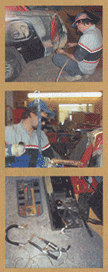
How many times have you bought a major or even a minor tool, only to realize that you didn’t really know what you were getting? Sure, you were able to get by with your purchase, but how many times did you want to kick yourself – wishing you’d researched just a little more?
At our shop, I feel like we’re standing at the crossroads. Changes are happening all around us, yet we’re patiently waiting to see which way technology is going to lead us in the inevitable search of the ultimate resistance spot welder.
I have to admit. My personal experience with these welders is somewhat limited. Back in 1977, I started work at an independent shop that had one of those “spot welders” that was capable of single-sided spot welding only. I’d heard many opinions about such machines – comments ranging from, “They’re great if you get one of the good ones,” to “I wouldn’t have one of those things even if I had room for a freight train” – coming from some of the more experienced (or were they just more set-in-their ways?)
Technicians
Of course, I had to find out for myself so I drug out the dusty beast from the dark corner where it’d been residing without any exercise for quite some time. I had a Mustang sitting in my stall that needed a new cowl side panel welded in place so it appeared to be the perfect guinea pig to test my newfound “toy.”
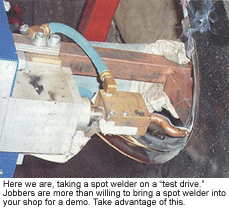
With the open-mindedness of an eager-to-learn novice, I cleaned the new and old panel. I noticed the panel didn’t quite lay flat, but it was “close enough,” as instructed by one of my more experienced coworkers.
I proceeded to “spot weld” the panel in place. As my work progressed, you could see my smile getting bigger and bigger. I was grinning because I didn’t have to drag that torch out to either braze or steel-weld that piece in place, causing additional sweat and time out of my day.
But my grin began to disappear as I started hearing “pop” after “pop,” as some of the “spot welds” set themselves free. The stress from the not-quite-fitting panel had leveraged some of the welds apart as the panel cooled, showing me that I couldn’t trust the strength of these welds to hold my panel in place for anything more than tack welding. After this revelation, I was destined to drag out that fire-breathing torch to ensure the panel would stay in place.
Although my first experience with a “spot welder” was less than I’d hoped for, I did continue to use it occasionally to “tack” a panel in place prior to welding it.
After MIG welders came onto the scene, I quit using spot welders altogether, leaning on the spot timer and spot attachment for such tacking
Operations
But technology has advanced since then. These days, the Squeeze-Type Resistance Spot Welder (STRSW) is a favorite welding tool in the autobody repair business.
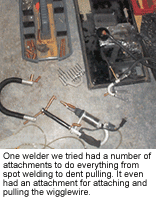
Because times – and these welders – have changed, I’ve spent the last few months reading, traveling to NACE, calling jobbers and generally asking others in the industry about these welders to increase the odds of maybe buying the ultimate welder for our application. Let’s dissect the information I’ve compiled about these time savers to see if we can take some of the mystery out of shopping for a state-of-the-art resistance spot welder – and decrease the odds of it becoming one of those dust-covered demons hiding in the corner.
Going for a “Test Drive”
One of the first things I found when shopping for one of these welders is that people are willing to bring them to your shop to show you how much time they can save you. Mike Stafford of Valley Paint and Bob Gilmore of ABC Color were two such representatives who brought a couple of these machines into our shop to help us decide which, if any, of these welders best fit our needs.
Be sure to take advantage of these demos, and “test drive” enough welders to satisfactorily answer the questions you may have regarding these welders. Although these demos will involve more time and concentration than you expected, allowing adequate time for them will pay off. These welders represent a major investment so don’t feel intimidated about asking questions while you’ve got the jobber there. Better to ask now than to kick yourself later when you find you bought the wrong welder.
Before a jobber arrives with a welder for you to test, I’d advise you to have a vehicle set up and ready to weld a panel on. That way, you can do it while the jobber is there to help you. These machines have great capabilities, but as with any new experience, there’s a learning curve involved here.
When one of the jobbers got here with his welder, we didn’t have a vehicle near a ready-to-weld state. The jobber was willing to do whatever it took to give us a good demonstration of the welder’s ability, so he offered to come back. But I elected that he just leave the welder with us and we’d try it on our own.
That proved to be a mistake. Not only was the welder’s performance less than anticipated, it wasted the technician’s time because we didn’t adequately understand the preparation. I’m sure the jobber described the procedure correctly prior to leaving the welder with us, but one little detail that we overlooked proved to waste everyone’s time. I should’ve just called the jobber when we had the panel ready to weld and asked him to come back in – like he offered to do. If I had, I’m sure the welder he showed us would’ve proven just as viable for our use as any of the others we looked at.
Aside from this problem – which was my own fault – I see only two downsides to these welders: the price (which is about five to 10 times of a MIG welder) and the size of some of these units. I envision trouble rolling these units between vehicles and through passageways. Although this can be worked around, it’s a little cumbersome. I’ve seen too many tools that work well but don’t get used because they aren’t handy. Still, despite the varying amount of bulk and awkwardness, these welders have great potential for becoming one of your favorite tools.
What I Learned from the Demos
Both of the welders presented to us had features and selling points that sounded great.
One necessary feature was the ability to achieve enough current at an acceptable rate, or duty cycle, to keep the welds constant. Cycle time between welds is very important. Although it’s only six to eight seconds, there’s still a tendency to rush and to reduce that six to eight seconds per weld down to under a second. What this does – besides speeding things up – is compromise the integrity of the job.
I’ve also been advised by more than one welder representative to watch out for models that have been designed to work with the power supply available in Europe. It seems that the power supply in Europe is different enough to cause different duty cycle ratings from the same machine when used with our 60-Hz power supply here. It just makes good sense to use a machine designed to work with our power supply. It would be a miserable failure if your welder started off welding great, only to have the later welds in a session come out weak because of lack of current. We need welds we can count on.
A duty cycle that achieves consistent welds can be accomplished a couple of ways. We’ve lived in a “solid state” age for quite some time, yet some of these welders still have the old-style transformers inside of them while others have inverter technology incorporated inside them. I even tried one welder that had batteries inside that you kept charged to take care of the high power surge demands without requiring a high-amperage circuit.
You’ll notice the inverter welders are more compact, yet seemingly still produce a nice-looking weld that the maker assured me had the necessary strength. Though I have a mind that accepts new technology only after it’s been proven to me, I do see some advantages to this new inverter welder line of thinking. But just as the tube-type guitar amplifiers of old have a certain reverence associated with them in the music industry, I feel there will always be a mix of opinions about which type of welder is the best.
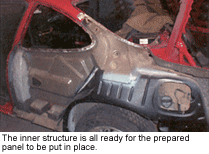
You’ll also have to decide whether you want a liquid-cooled or air-cooled welder. Some of these welders are liquid cooled all the way to the tips, while others may have liquid-cooled transformers or even air-cooled only. It seems that more of the inverter-type welders are less likely to be liquid cooled.
Although solid-state technology produces less heat as a rule, these welders will generate a good amount of heat by the time you weld a side on a vehicle – no matter what they’re constructed of. No one I talked to argued the fact that a hot welder welded the same as a cool one, but some did tell me that their welders were less prone to heat-related problems because their solid-state technology has the ability to keep output consistent by using a microprocessor.
Another point that surfaced more than occasionally was the “squeeze pressure” issue. Although it seems that virtually all of the welder manufacturers have addressed the need for adequate squeeze pressure to ensure solid, consistent welds, they have different theories regarding what’s “adequate.” Some tell me that you just have to watch for enough pressure – debatably around 300 to 400 pounds per square inch – while others tell me you need varying pressures during the weld cycle to keep from sinking in the weld while hot and ending with more pressure after the current drops to forge the weld.
During one of the welding demos, I also witnessed what happens when there’s contamination or a gap between the two panels being joined: A hole is blown through these panels. Adequate squeeze pressure will minimize this from happening because it’ll tend to squeeze away some of the contaminants and, of course, some of the gaps.
Seeing Spots
Although all the welders I looked at are seemingly easy to use, I’d recommend some sort of training procedure for any of your technicians who plan to use these welders. Some of the welder manufacturers offer some pretty extensive training, and I understand that I-CAR has some revised training to complement these welders, too.
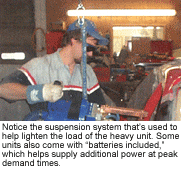
A couple of things that go without saying – but I feel I should say them anyway – are:
- Practice. Make test welds on scrap that’s of similar makeup to the panel you’re preparing to weld. Once you have some test welds, tear them apart to see if the weld is strong.
- Keep your machine ready. Some of the machines will require more time keeping them tuned than others will. Some manufacturers suggest sharpening the tips periodically, while others I spoke with offered replaceable tips, which they said would give more consistent results inexpensively.
Many OEMs are approving the use of these welders, yet a few still seem hesitant to jump on the bandwagon. I understand there’s an effort to get some new SAE standards in regard to these welders. Once these are established – and I’m only speculating here – I’d guess that additional OEMs will join in. For now, it’s important to understand that most structural components (frame rails, etc.) still need to be MIG welded.
Although I don’t yet feel prepared to jump on the bandwagon and grab up the first welder that’s priced within our budget, I do feel that my understanding of these impressive time savers has increased tenfold over the past few months. Still, it seems like for every question I have answered when researching these creatures, two more questions pop up.
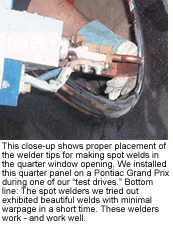
If we had a shop in a larger city with the workflow that goes along with it, I think I’d jump on one of these welders. But for a shop in rural America, this welder would be sitting a good percentage of the time. Because these welders are a major investment, I’d need a steady stream of panel replacements to justify the expense of the welder that I’d pick. I’m not saying that we won’t be buying one of these beauties. I just have to spend more time weighing the pros and cons before jumping.
I can tell you one thing though. Throughout all of the research I’ve done, I’ve yet to find anyone who disagrees with the fact that you’ll save time using these welders. You absolutely will. What we don’t know, and what only you can determine, is if one of these welders will pay for itself in your given situation.
Writer Keith Combs is the body shop manager at Bill Roberts Chevrolet in Bolivar, Mo., and a GM/ASE Master Collision Repair/Refinish Technician of the Year. He’s been in the collision repair industry for 23 years.
9 Reasons to Consider STRSW
1. There’s little distortion from heat.
2. No filler wire, rod or shielding gas is required.
3. No grinding is needed.
4. It inhibits the corrosion process.
5. It requires far less skill than the MIG weld process.
6. It’s much faster than MIG welding.
7. Cleanup of weld areas is minimal.
8. Smoke and fumes are negligible.
9. It creates a more invisible repair.













